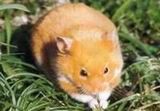|
햄스터 (동물이름사전)
| 제목: | 햄스터 (동물이름사전)
| | 올린이: | Administrator (kusnij@naver.com)
| |

| 해상도: 160x111
파일크기: 5625 Bytes
촬영일: 2004:06:15 12:54:30
등록시간: 2004:06:15 12:33:56
|
햄스터 (동물이름사전)
명주쥐 (햄스터, 비단털쥐)
학명: Muridae
영명: hamster
[분류] 쥐목(Rodentia) 쥐과(Muridae)에 딸린 설치류. 대표적인 대표적인 햄스터로는 다음과 같은 종이 있다.
[형태] 몸길이 12~15cm, 몸무게 100~150g로 손바닥에 올려 놓을 수 있는 크기다.
햄스터는 작고 동그란 몸집에 다리가 짧고 배를 바닥에 붙이고 걷는다.
치밀하게 나 있는 털은 부드러우며 몸은 매우 유연하다.
큰 귀와 긴 수염 그리고 날카로운 발톱을 가지고 있다.
크고 부리부리한 검은 눈은 윤이 난다.
[생태] 야행성으로 밤에 활동한다. 초지나 들판과 같은 광활한 지역에 서식한다. 곡식, 씨앗, 나무 열매, 채소 등을 잘 먹으며 작은 벌레도 잡아먹는 잡식 동물이다. 수명은 평균 2~3년이다. 종에 따라 7~8년을 살기도 한다.
[습성] 다람쥐와 같은 설치류와 마찬가지로 볼주머니가 있어서 먹이를 저장하는 습성이 있다. 시력이 나빠 아주 가까운 곳만 볼 수 있으며 주로 청각과 후각을 사용한다. 두 발로 서기도 하며 앞발을 정교하게 움직여서 털을 고르거나 먹이를 먹는다. 돌 틈이나 나무울타리 안 등에 0.6~9m에 이르는 굴을 파고 산다. 볼주머니에 모아온 먹이를 굴 안에 비축한다.
[번식] 골든 햄스터의 경우 혼자서 생활을 하며 교미할 때에만 암수가 서로 만나고 교미가 끝나면 수컷은 떠나고 암컷 혼자 새끼를 기른다. 한 달이 지난 후 새끼는 독립해서 나간다.
[기타] 1839년 영국의 동물학자 조지 워터하우스가 시리아에서 처음으로 골든햄스터에 관한 기록을 남겼으며 Cricetus auratus라는 학명을 붙였다. 예루살렘에 있는 Hebrew 대학의 Aronin 교수가 1930년에 시리아의 사막에서 새끼를 키우던 야생 햄스터를 데려와서 실험동물로 사육하려고 시도한 것이 최초의 사육햄스터이다. 지금은 애완동물로 전세계에서 널리 사육되고 있다. Hamster는 '비축하다', '축적하다'는 뜻의 독일어인 hamstern에서 유래하며, 이는 햄스터가 먹이를 볼주머니에 저장하는 습성이 있고, 야생에서 곡식을 모아 굴안에 저장하는 행동을 하기 때문에 붙여진 것으로 보인다.
가장 대표적인 시리아햄스터(황금햄스터, 골든햄스터)는 중동지역이 원산지이며 애완용으로 많이 기른다. 몸통은 12 ~ 17cm, 몸무게 170g가량. 꼬리는 아주 짧으며 다리도 짧고 귓바퀴는 둥글다. 몸의 등은 아름다운 주황색, 목과 몸아랫면은 회백색이고 앞가슴에 암갈색의 점무늬가 있다. 임신 기간은 15 ~ 16일이며 생후 1개월만에 다 자란다. 새끼는 태어난 지 3주일후에 젖을 뗀다. 성질이 극히 온순하여 실험동물로도 많이 쓰인다. 시리아, 이스라엘, 요르단, 루마니아, 불가리아, 소아시아, 이란 등지에 분포한다.
다음은 햄스터의 종류에 대한 Lorraine Hill의 분류이다.
가장 많이 애완용으로 사육되는 햄스터는 5종으로 다음과 같다.
| Common Name | Scientific Name | Alternative Names |
|---|
| Syrian Hamster | Mesocricetus auratus | Golden Hamster, Fancy Hamster, Teddybear Hamster, Standard Hamster |
| Dwarf Campbells Russian Hamster | Phodopus campbelli | |
| Dwarf Winter White Russian Hamster | Phodopus sungorus | Siberian Hamster, Djungarian Hamster |
| Chinese Hamster | Cricetulus griseus | |
| Roborovski Hamster | Phodopus roborovskii | |
이외에도 다음과 같은 종들이 있다.
| Common Name | Scientific Name | Alternative Names |
|---|
| European Hamster | Cricetus cricetus | Common Hamster, Black-bellied Hamster |
| Rumanian Hamster | Mesocricetus newtoni | Romanian Hamster |
| Turkish Hamster | Mesocricetus brandti | Brandts' Hamster |
| Ciscaucasian Hamster | Mesocricetus raddei | Georgian Hamster |
| Ladak Hamster | Cricetulus alticola | |
| Chinese Striped Hamster | Cricetulus barabensis | |
| Mongolian Hamster | Cricetulus curtatus | |
| Eversmann's Hamster | Cricetulus eversmanni | |
| Tibetan Hamster | | |
| Lesser Long-tailed Hamster | Cricetulus longicaudatus | |
| Armenian Hamster | Cricetulus migratorius | Migratory Grey Hamster |
| Greater Long-tailed Hamster | Cricetulus triton | Korean Hamster (비단털쥐) |
| Cricetulus obscurus | |
| Cricetulus pseudogriseus | |
| Mouse-Like Hamster | Calomyscus bailwardi | |
| Calomyscus baluchi | |
| Calomyscus mystax | |
| Calomyscus urartensis | |
Calomyscus baluchi, Calomyscus mystax, Calomyscus urartensis의 3종은 Mouselike Hamster(Calomyscus bailwardi)의 아종으로 분류하기도 한다. 이외에도 햄스터는 아니지만 햄스터라 불리는 설치류로는 South African Hamster (Mystromys albicaudatus, White-tailed Mouse), Maned Rat(Maned Hamster, Crested Hamster) 따위가 있다.
|
댓글 |
|---|
| | 손님 |
|
도움정말많이되었습니다..
앞으로 이 곳에서 동물에 관한 숙제를 하면 좋을것같아요^0^
암튼 짱!이에요~ |
| | 동물애호가 |
|
^^
애완용으로도 인기짱인 햄찌
왜?
개는 짖기땜에 않되고
고양이도 소리땜에 않디는데
햄스터는 소음도 적고
톱밥관리만 잘 해주면 진짜 굿잡!
단,가족중에 쥐 싫어하는사람 있으면 좀 비추 ㅎㅎ;; |
^o^
동물그림창고 똑똑전화 누리집
^o^
|
|
|